The 2nd series Appia Berlina (Click here to read about the Series I) was first shown to the public at the “1956 Salon de l’Automobile” in Geneva, Switzerland. The decision to redesign the Appia was taken after it became evident that sales of the Appia 1st series had eroded due to severe competition by such newcomers as the Alfa Romeo Giulietta and the FIAT 1100/103. The replacement for the Appia came at at time when Lancia had produced about 20 thousand such vehicles. Lancia’s philosophy for the 2nd Series Berlina was one of further refinement of the existing model, in the areas of bodywork and performance.
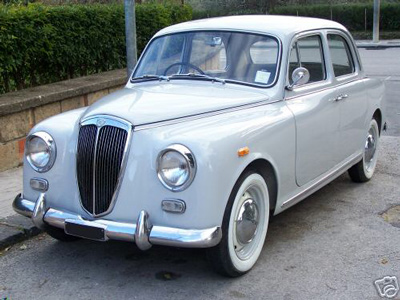
This classic Appia is for sale on ebay, and is a right hand drive model. still in use on Italian roads. Some Italian drivers prefered right hand drive even though the traffic was on the right lanes. One advantage of rhd was that it was less likely to run
over pedestrians -- in the absence of sidewalks - -on right hand turns.
|
Prototypes
The preparation that led to the 2nd series Appia Berlina was done in great secrecy. For over a year, the company rented an apartment in a Turin suburb for the small team of engineers that could thus prepare the new model in isolation, far away from the distractions of the factory where the activities were above all concentrated on Lancia’s race department – Formula One and Sports Cars alike. The first roadworthy prototype for the 2nd series Appia Berlina was silently outsourced to a small workshop on the outskirts of Turin. It was at this workshop that three men were given the job to put the prototype of the Appia 2nd Series together. Most remarkably, so goes the story, none of these individuals actually knew whom their actual client was for which they were building the car! The prototype was used to draft the final design, at the completion of which this prototype was crushed. Thereafter development shifted to the construction of 4 or 5 camouflaged “mules” that were prepared for road testing. An anonymous but befriended “Carrozzeria”, so it is reported, assembled these “mules”.
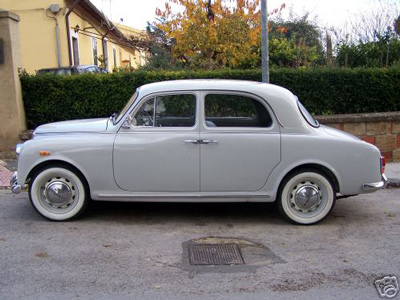
The biggest visual change was the adoption of a more distinct three box configuration.
This Appia can be found on Ebay.
|
In their effort to maintain secrecy about the development of the 2nd series Appia during the road testing phase, Lancia’s Headquarters frantically called upon some of their coachbuilders and friends to place orders with the suppliers for the various modified components. Thus it soon appeared that there were a bunch of small “Carrozzieri” and other workshops that were ordering thousands of headlight units and other parts, and that were ask by their parts suppliers whether they had gone “nuts” - after all these large quantities of parts did by far exceed the hitherto regular operations of these small artisans.
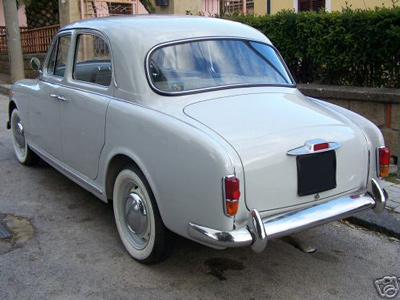
Note the taillights for the home version differ from the smaller lights of the Lucas equipped model, below.
|
Coachwork
The Appia Berlina 2nd Series struck the automobile scene as a welcome and pleasant surprise. The car was clearly identifiable as a derivate of the 1st Series, but had, through a refreshened design, definitely gained in elegance. The most striking feature of the new design was the abandonment of the sloped back of the 1st Series in favor of a real trunk. Thus, the Appia went from a two-volume to a three-volume body style. The ”bauletto” (trunk) design as it was similar to that of the 1954 Mercedes 180 and 220 series. In the process the Appia gained 140 mm (5.5 inches) in overall length; height was reduced by almost 20 mm (ľ inch) but the wheelbase and the width of the car remained virtually unchanged so as to contain retooling costs.
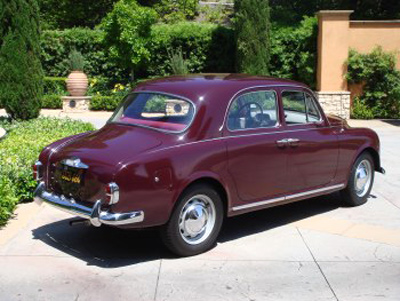
In either a light or dark color, the lines of the Appia were pleasantly accentuated.
|
The front-end of the car underwent only a very light facelift whereby the 1st Series Berlina’s circular indicator lights were replaced by larger rectangular units, while the aluminum bumpers were dropped for more sturdy chromed steel units with bumper overriders. All glasswork, with the exception of the rear windshield was kept exactly the same as in the 1st Series; the rear windshield was enlarged, which meant a real improvement over the 1st Series. The new trunk necessitated some reworking of the rear fenders that now showed moderate “finning” to the design clues adopted earlier by the German and American car manufacturers.
The Aurelia-style 1st Series Appia tail lights were enlarged and now had separate turn-signal indicators incorporated;export models to the North American markets had to be fitted in accordance with the USA Department of Transportation requirements Lancia mounted enlarged taillights (sourced from LUCAS in the United Kingdom and of design found on the period Morris Oxfords, and used also on Maseratis and Ferraris) along with external rearview mirrors (again manufactured in the United Kingdom. The Appia 2nd Series was offered in well-chosen colors that all gave the 2nd Series car a fine appearance.
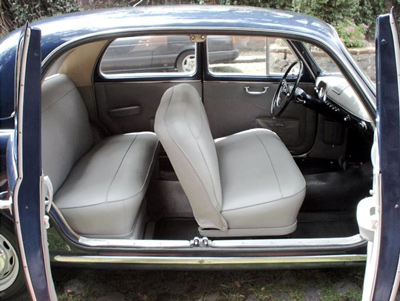
The interior featured many changes from the Series I, including a new instrument cluster. Note small circular ashtrays on far ends of dashboard.
|
Interior
The 2nd series Appia came with many improvements to the interior.
In particular the layout of the dashboard was revised and now showed a design that would remain unaltered until the very last Appia Berlina that was built, and thus until the last of the 3rd Series Berlina. The dashboard benefited from some tasteful padding in the upper part; the instrument cluster comprised two round parts, the left one housing the oil pressure gage and the fuel level indicator, as well as directional flashers, the right one the speedometer and kilometer indicators – total as well as trip. The radio could be placed either centrally on the dashboard, or could as an option be integrated in the interior rear view mirror. The odd looking, light colored, steering wheel of the 1st series Berlina was replaced with a very tasteful steering wheel of a design that would subsequently be copied in grand style and used for many years to come by Jaguar.
On the Appia 2nd Series Berlina’s steering column we find the stalks that allow changing the position of lights and operation of the direction indicators. A less appreciated change that came with the 2nd series was that the separate seating arrangements for front occupants of the 1st Series was dropped for a single bench, with a reclining back. The 2nd Series berlina maintains the column shifter of the first series, but the gear selection pattern now follows a more conventional flow; first gear is engaged by pulling the gear lever towards the driver and up, whereas second gear is found opposite to first, while the third gear is engaged by pulling the lever from neutral up, and 4 th gear is directly opposite to third; reverse is engaged by first pressing the lever away from the steering wheel and then downwards.
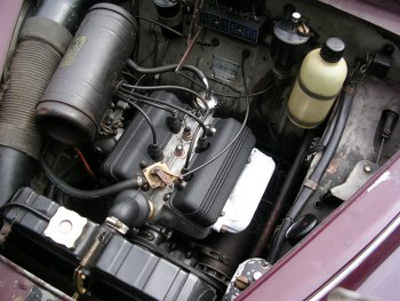
Second Series engine was still 1100cc, rated at 34 hp.
|
Engine and Mechanicals
Performance
The Appia 2nd Series Berlina performs well on the road; similarly to the 1st Series Berlina it is a car that is very stable even when driven hard around corners. The 2nd Series’ performance in terms of acceleration and top speed remain however rather disappointing particularly when compared to the likes of the Giuliettas by Alfa Romeo. More than before the Appia now distinguished itself as a classy, well built and above all comfortable people mover. Maximum speed with 4 passengers on board was increased by about 10 km/hr compared to the 1st Series berlina and now reached about 130 km/hr; it would take the car about 80 seconds to reach top speed from stand-still, while the 100 km threshold could be reached in about 26 seconds.
Depending on a more or less sporty driving style, fuel consumption would range from a minimum of 12.1 to 9.5 km/liter (or approximately 28 to 22 miles per US gallon); full tank capacity was maintained at the level of 38 liters (or about 10 US Gallons) and therefore sufficient for some 400-kilometer trip (250 miles).
A more appealing Appia
The Appia 2nd Series Berlina was definitely a strong contender on the Italian car market where people appreciated the car for the very well built quality, its classy but still subdued looks, and its refined mechanics. Nevertheless, the Appia 2nd series remained a relatively expensive car, but this aspect seemed now of lesser importance than with the 1st Series Berlinas. Italians were at the time reaping the benefits of the Marshall Plan and this meant that they availed from increasing purchasing power. Being the people that Italians are, they increasingly tended to saturate their thirst for (near) luxury items and the Appia 2nd Series - as well as an increasing number of its derivates churned out by the coachbuilders - meant that they finally could enjoy riding in fashionable style over the rehabilitated national and provincial roads.
The Italian automobile magazine Quattroroute concludes in its road test of the Appia 2nd Series (Quattroruote No.8, September 1956): “The Appia 2nd Series is improved considerably both in terms of vehicle appearance as well as vehicle dynamics; the new version is definitively more convincing of an automobile than then the 1st Series Berlina; more than performance it is the car’s elegance and quality construction, as well as the overall comfort and the general road-holding capabilities that make it a special car; it can be stated with great certainty that these aspects will persuade many potential buyers to purchase a new Appia 2nd Series Berlina.”
The 2nd Series would survive for three years, and thus until the arrival, in 1959, of the final and ultimate version of the Lancia Appia. the third series, was introduced.
Below are some images from the Series II sales brochure and owner's manuals.
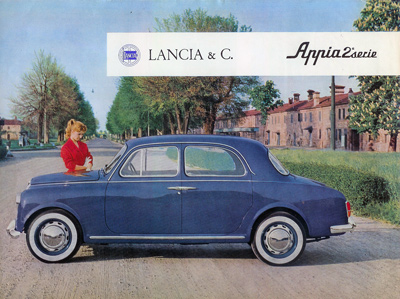
.
|



